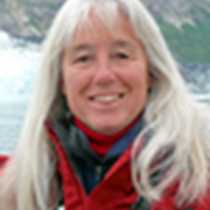Saginaw Channel & Juneau
This morning the National Geographic Sea Bird was cruised the waterways north of Juneau in search of marine life and photogenic scenery. Once again we started the day with some humpback whales. A mother and her calf shared some close moments and then dove in synchrony. Soon they will be migrating to Hawaii. We found other whales resting peacefully near our vessel. We had a quality experience watching an endangered species in its natural environment without disturbing the animals.
We noticed many bald eagles stationed on the mud flats at the mouths of salmon streams as we cruised along the shoreline of Douglas Island. The birds help to clean up the remains of the spawned-out fish.
Later in the morning, Wellness Specialist Darcy offered chair massages, helping to relieve tension from camera straps and photo editing.
Mike and C.T. co-led a photographic presentation with examples and recommendations for better composition. This was followed by intensive hands-on sessions with all the photographic experts to further acquaint people with the use of their cameras.
The National Geographic Sea Bird moored alongside Juneau’s City Dock, dwarfed by the mega-cruise ships that were also in town today. From there we boarded motor coaches for our visit to the Mendenhall Glacier. Our glacial experience had many facets. The Visitor Center has a commanding view of the glacier, many educational exhibits and a very nice shop. It was the first Forest Service visitor center in the nation, dedicated in 1962 to the “understanding and enjoyment of glacial phenomena.”
Some people walked to a viewpoint for a closer look at the Mendenhall Glacier. It was especially blue in the surrounding mist. A huge frothy waterfall cascaded down to its right. Others experienced a walk along Steep Creek looking for the bears that had left the grass flattened beside the creek. Bears are a messy bunch and had left fish carcasses, tails and heads strewn about; the fishy smell still lingered in the air. Beavers diligently labor to build dams that would obstruct fish passage in Steep Creek. Forest Service employees regularly remove the blockages so the salmon can carry on and complete their life cycle.
After departing the glacier, our tour continued to the excellent Alaska State Museum, where each room displays a different aspect of Alaskan history, native culture or wildlife. Past the entrance hangs a giant globe with various kinds of geographic information projected in cycles on its surface. Some people also elected to walk in town and visit the shops, looking for end-of-season bargains on gifts.
Back on board, hundreds of gulls – glaucous-winged, mew, Thayer’s and Bonaparte’s – sat on the water’s surface beside our ship. It was quite an amazing visual and auditory spectacle.
The National Geographic Sea Bird left the dock in Juneau and continued her annual southbound migration. We looked forward to further adventures.




